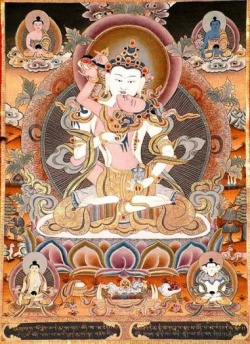The concept of Nirvana from a psychological point of view
Dr. Ruwan M. Jayatunge MD
The concept of Nirvana is more than 2500 years old. Throughout the centuries various scholars and philosophers tried to explain this concept using their limited knowledge.
In fact the concept of Nirvana is much more wide and difficult to explain in mundane terms. The Nirvana concept is often misunderstood and sometimes misused (eg - Nirvana Rock Band, Nirvana Night Club) in the Western world. Some Western scholars have tried to interpret it as a sensational feeling or like orgasm which was incorrect.
The concept of Nirvana was originally explained by the Lord Buddha (566-486 BC). His Lordship reached Enlightenment, at the age of 35, awakening to the true nature of reality, which is Nirvana (Absolute Truth). The word Nirvana comes from the root meaning 'to blow out' and refers to the extinguishing of the fires of greed, hatred and delusion.
When these emotional and psychological defilements are destroyed by wisdom, the mind becomes free, radiant and joyful and at death one is no longer subject to rebirth. Nirvana is the ultimate happiness.
The Buddha describes the abiding in nirvana as a state of 'deathlessness' and as the highest spiritual attainment, the reward for one who lives a life of virtuous conduct. Nibbana is meant specifically as pertains gnosis that which ends the identity of the mind with empirical phenomena.
Nirvana can only be explained to the 'unenlightened' by negation. Thus the Buddha tries to explain this deep concept to one of his disciples. He asks whether the fire, when it is extinguished, can be said to have gone north, south, east, or west. Nirvana, however, cannot be described as existing, not existing, both existing and not, or neither existing nor not.
Venerable Dr. Walpola Rahula explains the concept of Nirvana as
...The only reasonable reply is that it can never be answered completely and satisfactorily in words, because human language is too poor to express the real nature of the Absolute Truth or Ultimate Reality which is Nirvana. Language is created and used by masses of human beings to express things and ideas experienced by their sense organs and their mind.
A supramundane experience like that of the Absolute Truth is not of such a category. Words are symbols representing things and ideas known to us; and these symbols do not and cannot convey the true nature of even ordinary things. Language is considered deceptive and misleading in the matter of understanding of the Truth. So the Lankavatara-sutra says that ignorant people get stuck in words like an elephant in the mud. Nevertheless, we cannot do without langauge.
It is incorrect to think that Nirvana is the natural result of the extinction of craving. Nirvana is not the result of anything. If it would be a result, then it would be an effect produced by a cause. It would be 'produced' and 'conditioned'. Nirvana is neither cause nor effect. It is not produced like a mystic, spiritual, mental state, such as dhyana or samadhi.
People often ask: What is there after Nirvana? This question cannot arise, because Nirvana is the Ultimate Truth. If it is Ultimate there can be nothing after it. If there is anything after Nirvana, then that will be the Ultimate Truth and not Nirvana.
He who has realised Truth, Nirvana, is the happiest being in the world. He is free from all 'complexes' and obsessions, the worries and troubles that torment others. His mental health is perfect. He does not repent the past, nor does he brood over the future.
He lives fully in the present. Therefore he appreciates and enjoys things in the purest sense without self-projections. He is joyful, exultant, enjoying the pure life, his faculties pleased, free from anxiety, serene and peaceful.
As he is free from selfish desire, hatred, ignorance, conceit, pride, and all such 'defilements', he is pure and gentle, full of universal love, compassion, kindness, sympathy, understanding and tolerance. His service to others is of the purest, for he has no thought of self. He gains nothing, accumulated nothing, because he is free from the illusion of self and the 'thirst' of becoming.
Nirvana and human mind
A man is composed of six elements: solidity, fluidity, heat, motion, space and consciousness. All human knowledge is founded on particles and forces in space and time, which assumes the existence of four separate things. This cause many problems for humanity because the necessary connection between these things is unknown.
The mind-body dual is known as the 'psychophysical' problem and has been concisely formulated by the French philosopher and mathematician Rene Descartes in his 'Meditations', published in 1641. Descartes observed that the world consists of two basically different substances; mind and matter.
Matter occupies 3-D space, mind does not. He could not explain satisfactorily how these two substances, mind and matter; interrelate. Benedict Spinoza (1632-1677) saw mind and body as two attributes of the same substance, processes of one and the same thing expressed in two different ways.
What is the connection between human body and human mind? Can human mind gain higher neurological functions through evolutionary process? What does the theory of evolution has to say? Darwinian explanation is based on the extraordinary amount of data collected by the sciences, which is tied together by a number of hypotheses: the Earth and life develop through various physical, chemical, and biological processes, over billions of years.
Man evolved from the apes by the purely physical process of 'natural selection'; the same process through which all life evolved.
The scientific cosmology is thus one of continued development and progress through tremendously long periods of time. Homo sapiens have achieved a greater success in this regard. Their brain developed in to a higher juncture. The human mind has no limitations. The contemporary science had not discovered even 5 per cent of the human brain and its cognitive abilities.
Every day Neuro psychologists discover new schemes, and superior brain functions. They are of the view that human mind is an extraordinary system which is million times advanced than the newest computers. According to Buddhism, there is no division between physical and psychological aspects of life. The experience of the one influences the other.
Nirvana is cognisable by mind. In other words human mind can be trained in higher cognitive functions. When the mind reaches higher state it can understand advanced logical reasoning, high moral issues and so forth. Realisation of Nirvana is a form of achieving superior mental state.
It is a state in which one experiences the unity and the wholeness of everything as it is. This unity and interconnectedness of all things is, from a Buddhist perspective, objective reality.
Consciousness and Nirvana
The brian, thus, might not be pictured as a series of neural connections, but rather as a matter wave "system' that resonates in particular regions and dampens in yet others. What we call consciousness and memory may be pictured as the collective resonances and dampening of the entire brain-system.
Consciousness and perception may also be a resonance of the brain matter-wave system; an effect of the brain-system interfacing with the outside world. The degree of consciousness that one may have might depends upon the collective degree of the brain wave-system being in-phase with the environment. The more interactive and resonant the brian-system is with the environment through the senses, the greater may be the degree of consciousness.
The Buddha taught that consciousness arises only out of conditions; without the presence of conditions there is no consciousness. Consciousness depends on form, feelings, perceptions and impulses for its arising and cannot exist independently of them. It is essentially an observing function.
Harmonisation of unconscious and conscious
An individuated individual is one in whom the unconscious and conscious are harmonised, and ego is decentralised. This is achieved by getting in touch with the unconscious, without allowing the ego to be overwhelmed by it. Ego has an explicit value.
Functions which exist below the threshold of consciousness need to be brought above that threshold, repressed shadow contents need to be acknowledged, and the major archetypes of the collective unconscious.
In the human psyche, according to Buddhism, nine levels of consciousness exist. The first five correspond to the five senses and are called: eye consciousness, ear consciousness, nose consciousness, tongue consciousness, and body consciousness. The remaining four are levels of mind consciousness.
The sixth level of consciousness controls the perception of the outer and material world. The seventh level concerns our inner and spiritual world and guides our capacity for thought and judgment. The eight level is the "store" of Karma (alaya). The ninth level of consciousness is the basis of all spirituality and is called Amala, which means pure and uncontaminated.
Enlightenment results from the state where the conscious mind is depotentiated of energy through long practice and discipline, working with meditation. Nirvana the ultimate goal of Buddhism is a state in which there is no suffering or desire, and no sense of self.
It is a state of perfect happiness. Doctrinally Nibbana is said of the mind which no "longer is coming and going but which has attained a status in perpetuity, whereby "liberation can be said ergo the freed mind is equal to Nibbana in Buddhist doctrine.
Elsewhere the Buddha calls Nirvana 'the unconditioned element.
Beyond Freudian theory
Basically Freud explained about the pathological mind. Psychoanalytic theory is based on the conscious and unconscious psychological processes. Freud developed a theory of behaviour and mind, its urges or drives also thoughts.
Unconscious motivation is the key idea of psychoanalysis. In the psychoanalytic perspective super maintain concept like Nirvana is difficult to explain. The theory of ultra super ego (read psychoanalysis with Clinical Evidence by Dr. Ruwan M. Jayatunge - Sarvodaya Vishva Lekha Publishers 2004 Colombo, Sri Lanka) gives some background ideas about the functions of superego and the ultra super ego in people who have a developed psyche. People with highly developed psyche have diminished levels of id functions and their spiritual dimensions is prominent.
Existentialism and the concept of Nirvana
Comparisons between Buddhism and the various schools of existentialism have revealed a number of parallels. Such studies have frequently centered on each tradition's metaphysical approach and the fact that they all appear to share some form of phenomenological methodology.
Existential psychology deals with basic issues of existence that may be the source of present conflict within a person. These concerns are universal and inherent in the human condition; death, freedom, and essential aloneness and meaningless. The emptiness 'is the human condition to which both Buddhism and Nietzsche respond.
The word Dukkaha gives a deep philosophical meaning of suffering and emptiness. Dukkha is the Sanskrit word commonly translated as 'suffering'. The most important type of Dukkha, however, is Sankhara-dukkha, an existential incompleteness due to spiritual ignorance.
Existential psychology addresses the meaning of life and human freedom. The Buddha used Nirvana more as an image of freedom. Nirvana names the transcendent and singularly ineffable freedom that stands as the final goal of all the Buddha's teachings.
"This is peace, this is exquisite - the resolution of all fabrications, the relinquishment of all acquisitions, the ending of craving; dispassion; cessation; Nirvana".
Gestalt psychology and the concept of Nirvana
The word Gestalt means a unified or meaningful whole, which was to be the focus of psychological study instead. Gestalt psychology is based on the observation that we often experience things that are not a part of our simple sensations.
In perception, there are many organising principles called Gestalt laws. People cannot see the multidimensional reality because human senses are limited to three dimensions, yet the higher-dimensional world is only a subset of the multidimensional system.
An interrelated set of holistic principles is developed. The multidimensional world is then explored with this holistic logic system. This leads to commonsense interpretations of quantum physics effects and provides plausible answers to many unresolved questions, such as the whole versus parts problem, mind-body interaction, the inner structure of the human psyche, the beginning of life, and the creative nature of evolution.
The experiments of quantum physics showed that the atoms, the presumed fundamental building blocks of the universe, were, at their core, essentially empty. Quantum physics has thus brought about a radical new understanding both of the particles and the void. In subatomic physics, mass is no longer seen as a material substance but is recognised as a form of energy.
In Dhammapada, the notion of Nirvana is explained in thus:
"There is that dimension where there is neither earth, nor water, nor fire, nor wind; neither dimension of the infinitude of space, nor dimension of the infinitude of consciousness, nor dimension of nothingness, nor dimension of neither perception nor non-perception; neither this world, nor the next world, nor sun, nor moon.
And there, I say, there is neither coming, nor going, nor stasis, neither passing away nor arising; without stance, without foundation, without support (mental object). This, just this, is the end of stress."
Gestalt psychologists believe in intuition or Aha experience. This can be explained as an insight or rather sudden perception of critical relationship. Understanding the Nirvana sometimes achieved like Aha experience. Advanced cognitive abilities can grasp and understand some of the complex questions within seconds.
Conclusion
An important facet of Nirvana in general is that it is not something that comes about from a concatenation of causes, that springs into existence as a result of an act of creation or an agglomeration of causative factors; it was never created; it always was, is and will be. But due to the moral and mental darkness of ordinary, sansarically benighted sentient beings, it remains hidden from unawakened perception.








